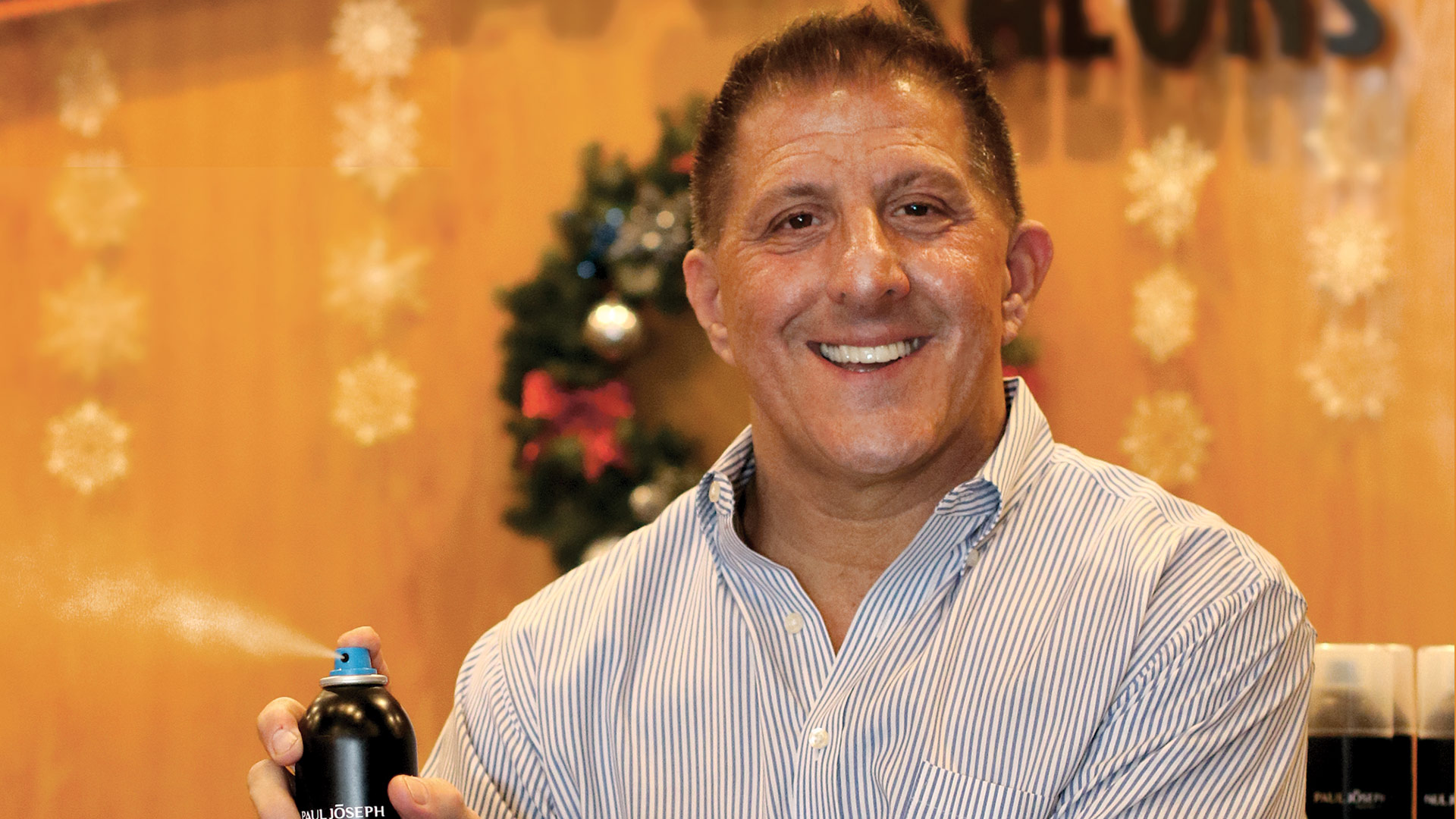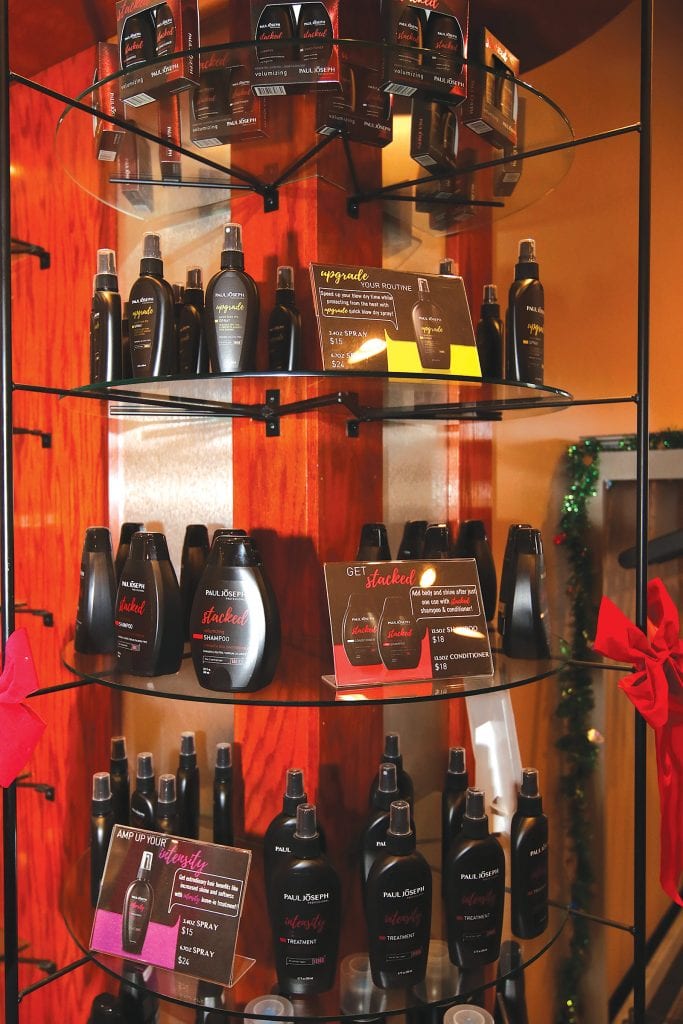Taking Hold
 More than 30 years ago, Paul DiGrigoli made it a goal to put his name on a line of hair-care products. It took nearly three decades to realize that dream, but ultimately it took more than time. It required him to step back from his business — or ‘away from the chair,’ as he put it — and attain the time and flexibility to fully flex his entrepreneurial muscles. There’s a lesson here, and he imparts it upon the many audiences who hear his motivational and hair-industry-focused speeches.
More than 30 years ago, Paul DiGrigoli made it a goal to put his name on a line of hair-care products. It took nearly three decades to realize that dream, but ultimately it took more than time. It required him to step back from his business — or ‘away from the chair,’ as he put it — and attain the time and flexibility to fully flex his entrepreneurial muscles. There’s a lesson here, and he imparts it upon the many audiences who hear his motivational and hair-industry-focused speeches.
Paul DiGrigoli couldn’t put his hands on it easily, but he knew he had the news clipping somewhere.
It’s a saved copy of a Daily Hampshire Gazette story on his salon in Easthampton, one of many news items he’s saved over the years. He doesn’t recall the exact date, but knows it’s from the late ’80s. The content he remembers most vividly — and references most often — are his remarks about someday having a product line with his name on it.
That someday turned out to be roughly three decades later, as DiGrigoli unveiled a full slate of products — everything from shampoo and conditioner to something that will reduce the time it takes to blow-dry hair (more on later) — about a year ago. The name on the bottle is Paul Jõseph, chosen because Joseph, his middle name, is much easier to pronounce than DiGrigoli.
And while that timeline certainly isn’t what he had in mind when he talked with the Gazette business writer back when Ronald Reagan was in the White House, there’s a reason why it took so long for the dream to become reality.
Actually, several of them.
They include everything from the immense amount of competition in this vast market segment and the difficulty of breaking in, to the vast amounts of research and trial and error that go into creating such products, to the challenge of simply getting products into salons. And perhaps the biggest reason is the time it takes to do all that and how DiGrigoli needed to get out from behind the chair, as he put it, and work on his business, not necessarily in it.
“Entrepreneurship is not an easy thing, and I think that, at the end of the day, you try to get to the point where the business can run without you,” he explained. “When you can do that, it’s a game changer because, for most people, they’re not running their business; their business is running them.
“Entrepreneurship is not an easy thing, and I think that, at the end of the day, you try to get to the point where the business can run without you.”
“I came to the realization that, in order to grow my business exponentially, I had to step away,” he went on, adding that he’s still very much involved in the many aspects of his company, but he doesn’t micromanage and does spend considerable time and energy grooming leaders to run these operations.
This has left him free of many of the day-to-day details and ‘distractions,’ as he called them, and with the time to travel the country speaking, write a book for those within the industry titled Booked Solid — the Ultimate Guide to Getting and Keeping Customers, grow and diversify his business with initiatives such as the new product line, and even take on some real-estate initatitives, such as a building he and some partners renovated on Capital Drive — it now boasts several tenants and will likely become the eventual home of his school and salon.
These are all lessons DiGrigoli tries to impart upon the audiences he speaks to on a frequent basis. These are most often cosmetology students and professionals already in the business. Many are where he was a few decades ago and generally have what it takes to get where he is now.
What they need to know is how to make that transition from being a stylist to being an entrepreneur, he went on, adding that he has plenty of guidance and advice for them on this subject.
“By stepping away, and by sitting still, I have been able to organize my thinking,” he explained. “When you organize your thinking, that’s pretty profound because you’re allowed to make the bigger decisions involving your company, not the smaller decisions; when you’re wrapped up in the day-to-day operations, you’re caught up.”
For this issue, BusinessWest talked with DiGrigoli about his new product line, but mostly about the ongoing journey that brought him to the day when he could put ‘Paul Jõseph’ on a bottle of conditioner, and the lessons this story offers — for people not only in cosmetology, but in every line of business.
Hair Apparent
DiGrigoli’s small office at his salon and school on Riverdale Street is crowded with photographs — there’s shots of him with Vidal Sassoon and John Paul Deloria, co-founder of Paul Mitchell, for example, as well awards from various local and national organizations, a few slogans in frames, and news clippings (but not the one mentioned earlier from the Gazette).

Paul DiGrigoli says it took many years of research, trial and error, and “tweaking” to bring his lineup of hair-care products to the marketplace.
There’s also a simple map of the 50 states, with the vast majority of them colored over with a blue highlighter. Those colored-in states are those that DiGrigoli has traveled to for his many speaking engagements, and when looking at it while talking with BusinessWest, he discovered he was a little behind in his work.
Indeed, Montana, still white on this map, needs to be crossed off the list, he said, adding that there are just a few states, mostly in the Midwest — Nebraska, South Dakota, and Wyoming — that he has still to visit.
That map, especially when absorbed in concert with all that other memorabilia, provides solid evidence of just how far DiGrigoli has come in his life and his career, which now spans nearly 45 years. It’s a story he shares with those in his audiences, and one that most in this market know by now.
It’s about an aspiring stylist and entrepreneur who was once living at the YMCA of Greater Springfield while enrolled in cosmetology classes at Springfield Technical Community College. Like most who break into this profession, he started out working for someone else before putting his own name over the door. And the name has been put on not just the salon, but also a cosmetology school that has grown steadily over the years.
And now, as noted, it adorns a wide array of products now available at his salon and many others in this region and outside of it.
The line, all with the Paul Jõseph name on the bottles, includes Stacked, a volumizing shampoo and also a volumizing conditioner; Lock It In, a color-protecting shampoo and color-protecting conditioner; Real Clear, a clarifying shampoo; Intensity, a ‘leave-in treatment’; Upgrade, a quick-blow-dry spray; and Elevate, a color-protecting hairspray.
Bringing each product to the shelves was a lengthy, challenging exercise, he told BusinessWest, noting that the marketplace is flooded with similar products, and for his to succeed, they had to be different and represent some form of improvement over what was already on the shelves.
As a result, he would often hear conflicting advice from customers and friends alike.
“What started it was my clients, who would say things like, ‘Paul, maybe you should think about your own product line,’” he recalled. “But there were other people who were telling me I was crazy to want to do that because of all the products that were already out there.”
Ultimately, there was more than enough motivation to persevere, he said, summoning numbers that he knows by heart and rattles off pretty much every time he speaks publicly to get his message across.

“Last year, consumers spent $46 billion — that’s with a ‘b’ — on hair care and cosmetics,” he said. “Women spent $12.5 billion on color alone.”
But bringing the Paul Jõseph line to the shelves was a lengthy and challenging process that began with customers voicing needs and requests for solutions, and continued with years of R&D, product refinement, and, finally, getting something ready for public consumption.
“Last year, consumers spent $46 billion — that’s with a ‘b’ — on hair care and cosmetics. Women spent $12.5 billion on color alone.”
He used the Upgrade product to get these points across.
As noted, it usually began with customer input. “People would say, ‘you should come up with a product that actually blow-dries my hair quicker, because I have two kids and I have to get them to school and have to get to work myself, and I don’t have time to do my hair, but my hair’s important to me,’” he recalled, adding that he took these marching orders and went to work creating something he believes is unique in the marketplace.
Upgrade has a vegetable protein in it, and it actually pushes the water out of the cuticle of the hair, he explained, adding that the product enables the user to reduce blow-drying time by a full 30%.
It came about through considerable work with a chemist he hired, and thorough testing of the product in two intriguing laboratories — his school and his salon.
“I would give it to all my students and my clients,” he explained. “And we would have feedback sheets and would get comments like ‘the fragrance is too strong,’ or ‘the fragrance isn’t strong enough,’ or ‘it’s making my hair too dry.’ We got all this information back, and I would go to my chemist and say, ‘these are my concerns; this is what we’re finding,’ and we’d tweak it.”
Head Counts
It was this way with all the products in the lineup, he went on, adding that it took more than three years to finally get Upgrade on the shelves. His portfolio of products — he’s always looking to add new ones — is now in 42 salons across the country (many owned by people who attend his speaking engagements).
The goal for the first full year was to be in closer to 100 salons, he said, adding that he is still quite pleased with the results and knows those numbers will grow steadily in the years to come.

Paul DiGrigoli’s branded hair-care line is a dream 30 years in the making.
“Slow and steady wins the race; this is a marathon, not a sprint,” he told BusinessWest, summoning one of the many time-worn axioms about business, entrepreneurship, and life that he imparts upon his audiences and business writers alike.
“If you love what you’re doing, you’ll never work a day in your life,” he said, borrowing another one he uses frequently. They may sound like clichés, he acknowledged, but they are words to live by and run a business by.
And this is the one of the many messages he leaves with his audiences during talks that are motivational in nature and generally positive in tone. Indeed, DiGrigoli will almost certainly remind his audiences of the hair industry’s long-term security and how, while they can buy shoes, books, and golf clubs on the Internet, they can’t purchase a haircut there.
“No matter how big the information age gets or the social-media platform gets, no one’s ever going to take our jobs,” he told BusinessWest, paraphrasing what he tells those at gatherings like the one he spoke at a few weeks ago in Baltimore. “No one’s going to walk down the street and say, ‘where’d you get your hair cut?’ and hear ‘I got it on Facebook.’ That’s never going to happen. We still have to touch people to cut their hair, and that’s never going to change.”
But his talks are also loaded with hard talk about how salon owners — and those in other lines of work as well — need to step out from behind the chair, figuratively if not literally, to get the business to the next level.
Elaborating, he said that, while most all of those he addresses are ready and willing to become more entrepreneurial, as he did, many are just not able because they’re still doing too much work in their business.
“It’s not that they don’t have the knowledge or have the experience — they’re just physically exhausted, period,” he explained. “They’re trying to be all things to all people, and that’s impossible.”
He knows this from experience, and to get his point across, he summoned an anecdote that many of his younger audiences might not relate to directly — but they get the point.
“It was like watching The Ed Sullivan Show,” he said, referencing the variety show from a half-century ago. “I was the guy with the plates — the guy spinning a whole bunch of plates at one time. He had five plates going at one time … he’d go over here trying to spin one plate, and then over there to keep another plate spinning, and when that one got wobbly, he’d go over there and get it spinning again.
“That was me,” he went on. “Until I learned to step back and take a snapshot of my business, knowing that I had the things, or skills, I really enjoyed doing, and other things I didn’t want to do because I wasn’t good at them. Once I found that out, it was a game changer.”
Other salon owners — and those in every other business sector — can change their game by taking a similar step back, he said, adding that the keys are having a team behind you and the passion to turn dreams into reality.
Making Do
When asked what’s next for him and what would have to be called his portfolio of businesses, DiGrigoli listed a number of goals and ambitions, from the very specific — writing a another book (this one for the public, not just salon owners) — to the very broad — making Paul Jõseph a “household name,” as he put it.
But his overriding ambition is to continue helping those in his industry — the 1.7 million stylists in this country, by his count — with everything from filling their scheduling books with appointments to diversifying their business operations.
Mostly, though, he’s focused on helping them becoming more entrepreneurial and able to work on their business, and not necessarily in it.
Yes, that’s another cliché, but it’s an important one, and he’s become a role model for how to take on that assignment — as that news clipping from 30 years ago, and all that have come since — will attest.
George O’Brien can be reached at [email protected]






